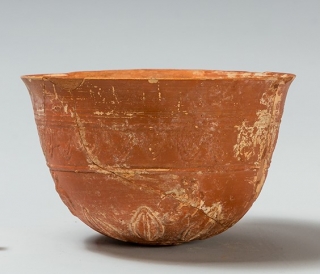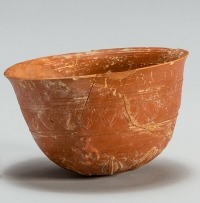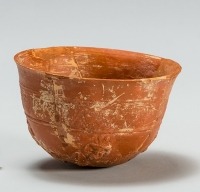You are here
Hellenistic moulded drinking cup - 2012.05
Hellenistic moulded drinking cup. 'Megarian bowl', with lotus petals and dramatic mask with a top-knot hairstyle (a prostitute?).
Title: Hellenistic moulded drinking cup - 2012.05
Author or editor: Emma Griggs
Culture or period: Hellenistic
Date: c. 2nd century BC
Material: Clay - Terracotta
Acquisition number: 2012.05
Dimensions: 85mm (w) x 54mm (h)
Origin region or location: Syria
Display case or on loan: 4
Keywords: Hellenistic, Megarian, Mould-made
J.R Green et al, Ancient Voices. Modern Echoes, Theatre in the Greek World. Exhibition Catalogue (Sydney: The Nicholson Museum, The University of Sydney, 2003), 71
L. Kurke, ‘Inventing the "Hetaira": Sex, Politics, and Discursive Conflict in Archaic Greece’, Classical Antiquity 16.1, 1997, 106-150
2012.05
Hellenistic moulded drinking cup
Drinking Bowl With hetaira Masks
Purchased in Syria and on loan from Emeritus Professor Graeme Clarke
Height 5.4cm; Diameter 8.8cm
This type of bowl appears in Athens during the last years of the 3rd century BC and was modelled after silver bowls. This particular drinking bowl is probably from the middle of the 2nd century BC or a little later. The place of manufacture is not clear.
The bowl has been reconstructed from fragments, and there has been some restoration. The bowl was made using a mould, and this particular mould appears to have been well-used. This manufacturing technique suggests that even unskilled assistants could have thrown the bowls. The simplicity of manufacture resulted in the rapid spread of this sort of bowl throughout the Mediterranean world. Moreover, it must have meant that the bowls were relatively inexpensive to buy.
Almost all production centres produced pieces with similar motifs, usually with leaves radiating from the base and with minor motifs in the space above them. The decoration on this bowl is in relief and comprises a kymation, an ornamental strip, below the lip. Above the radiating leaves are hetaira masks and, on the bottom of the bowl, there is a rosette. The bowl was covered with a glaze and intentionally fired red. The motifs on the bowl undoubtedly would have reminded the owner of symposia and the world of Dionysus, the Greek god of wine, fertility, ritual madness and the theatre. This bowl was probably used at symposia, as there was a long tradition of incorporating hetairai masks of this kind into such objects.
A simple definition of hetaira is ‘courtesan’ or ‘companion’; it is a synonym for prostitute. These definitions, however, miss the nuances and the history of the word. Greek does not always translate simply into English. Scholars often work within a binary of hetaira-porne, the main difference between the two being that of status. A hetaira was supported by one or two men and served as their companion at symposia and as a sexual partner. Hetairai are often associated with luxury and the elite, and were seen as ‘high-class’ prostitutes. In contrast, a porne was a common streetwalker; or she may have worked in a brothel, providing sex for payment to a large and anonymous clientele. But there is still much debate in modern scholarship about the concept and definition of the term hetaira.
J.R Green et al, Ancient Voices. Modern Echoes, Theatre in the Greek World. Exhibition Catalogue (Sydney: The Nicholson Museum, The University of Sydney, 2003), 71
L. Kurke, ‘Inventing the "Hetaira": Sex, Politics, and Discursive Conflict in Archaic Greece’, Classical Antiquity 16.1, 1997, 106-150
On loan from Emeritus Professor Graeme Clarke (received 9 March 2012)









